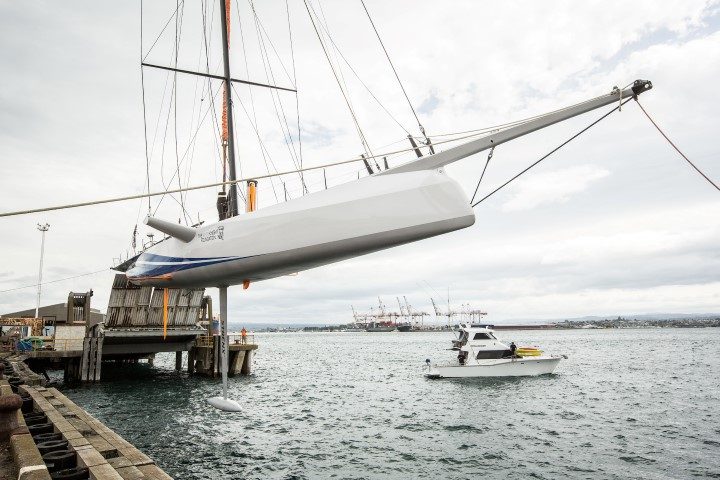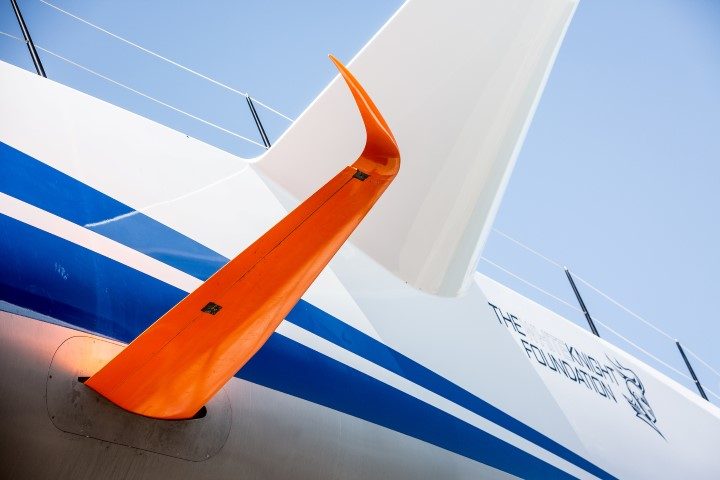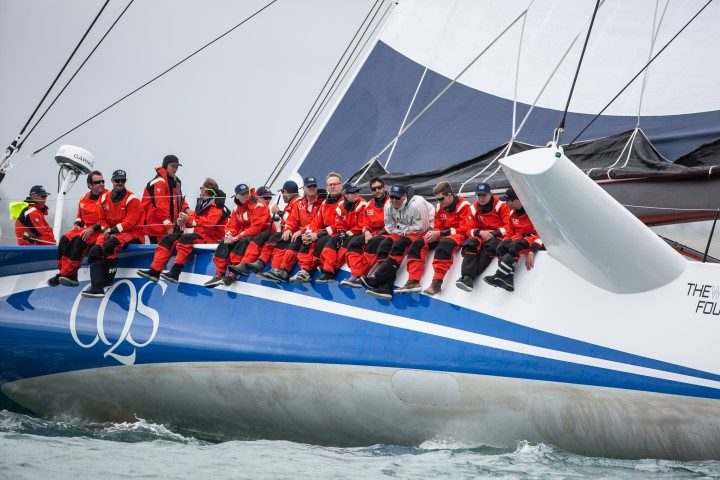‘Behemoth’ is a word which springs to mind or, perhaps more nautically, ‘leviathan’.
- Re-vamped maxi racer
- Extended hull
- Radical re-design
- Canting keel
- Twin foils
- Lightweight and fast
In the realm of modern maxi racers, ‘radical’ is almost the default description. The newly-launched CQS takes the meaning of the word to a new level.
The 33.7m CQS is owned by Australian Sir Michael Hintze and named after his company – a London-based, multi-strategy asset management firm. Describing her as unusual-looking is something of an understatement, but what accentuates her difference is that she’s emerged from the shell of a pre-existing maxi – and one that was hardly a slouch.

Her ‘in-body’ predecessor was Nicorette VI – built in 2004 and at that point a state-of-the-art 30m maxi. She was equipped with a canting keel and, with her carbon fibre/Nomex sandwich construction her hull weighed only 10 tons. Designed by Simonis Voogd Naval Architect and Yacht Design Studio, she immediately announced her racing pedigree by winning that year’s Sydney-to-Hobart race.
The new super maxi is registered in Sydney but the Nicorette VI/CQS metamorphosis is pretty much a New Zealand story.
The redesign is mainly from the drawing board of Auckland’s Brett Bakewell-White, with the deconstruction/reconstruction carried out by Tauranga’s Southern Ocean Boats. Auckland’s Evolution Sails designed the sail plan, and Hall Spars (NZ) the rig. Although CQS uses about two-thirds of the original hull, she’s almost unrecognisable from Nicorette VI.
While CQS is destined for the fast-paced life of the international maxi racing circuit, her first major challenge is this year’s Sydney-to-Hobart race, where she will square off against the eight-time line honours winner, the 30.5m Wildoats XI.
To participate in the Sydney-to-Hobart, CQS had to complete a qualifying race. This she did in November’s Round-White Island race. As a taste of what competitors across the Tasman might expect, she won the 320nm race in a fairly-convincing fashion, setting a new monohull course record and falling less than an hour shy of the all-class record (which includes multihulls).
The record – held by the ORMA60 trimaran TeamVodafoneSailing (now Frank Racing) – stands at 27hrs 7m 58sec. CQS missed it by 52 minutes.
CQS is skippered by Finnish-born Aussie Ludde Ingvall, who says the Round-White Island race was a good shake-down cruise which identified plenty of areas for improvement.
The Transformation
To lengthen the hull a portion of the bow was removed and replaced with a longer model. Its radical lines are underscored by a reverse bow and a long bowsprit. The yacht has always been relatively narrow but to support the new, much more powerful rig the shroud base was widened. This was achieved by adding aerodynamic ‘wings’ to contain the outer ends.
CQS’ most unorthodox feature, though, is her DSS aqua foil system.

Sailors and designers have been experimenting with foils for many decades, but until very recently it was always with small lightweight craft.
A keelboat does not lift its hull clear of the water like a foiling Moth, for example, but the technology can greatly increase the stability of a keelboat, lifting it a little, and thereby reducing its displacement, wetted surface area and resistance.
CQS’ DSS aqua foil system is an adaptation of this feature and she is one of the biggest boats currently using the technology. The system uses a sliding board that runs across the boat from one side to the other, and protrudes from the hull just below the waterline.
The board is deployed on the leeward side to give lift and added stability. In effect the hull becomes like an aeroplane with one wing. The faster the boat goes, the more lift the foil provides. This reduces the angle of heel and makes the rig and hull more efficient.
With CQS, the technology’s combined with the advantages of a canting keel. Says Bakewell-White: “We think canting keel and aqua foil are complementary technologies; they enhance each other.”
With the aqua foil out one side and the canting keel out the other, the ‘aeroplane’ now has two wings. For a boat that is relatively narrow on the waterline, this double dose of righting moment is a material performance enhancer.
Note – the foil was removed for the Round-White Island race, allowing the crew to concentrate on the vessel’s other features.
Sails & Rig
To design the sail plan, Evolution Sails’ Rodney Keenan used the University of Auckland’s wind tunnels. The addition of the wide platform at the stern was crucial to the design package and it allows a wide enough sheeting angle to facilitate the use of some truly huge headsails. As well as conventional jibs, the boat carries a wide selection of staysails.
With the longer bow, the rig is effectively further back in the boat. Back in the early 2000s, boats of this size had their masts about 40 to 42 percent back from the bow. CQS’s is closer to 47 percent. And while standard masts are raked around one degree, CQS’ is four degrees.

The weight of the sails was also a major performance consideration.
“We’ve built a set of sails that allows us to have the minimum number of sails on board to reduce weight,” says Keenan. “If you come off the plane because you’re carrying one extra sail which is 100kg, performance drops by 16 percent. We’ll probably only carry seven sails, where other boats of this size will carry eleven or twelve. If we can get rid of 1,000kg of sails, that’s a huge weight saving.”
One of Nicorette VI’s original components retained by CQS is the mast. It has new spreaders and some more carbon, and widening the stay base has allowed Keenan to put a lot more horsepower on it.
CQS skipper Ingvall is no stranger to the Sydney-to-Hobart race – he has won it twice. This year’s race should make for a fascinating duel.[/caption]
‘Behemoth’ is a word which springs to mind or, perhaps more nautically, ‘leviathan’.
White Pointer has earned the respect of discerning customers in New Zealand and Australia, attracting a loyal and ever growing following for its high-quality, rugged and totally dependable aluminium trailer boats.
The hardtop SP635 shares the same underpinnings as the popular SF 635 which was a completely new model back in 2020.
The pride and joy of a multi-generational family, Bliss resides on a pier that’s home to a couple of other Elite motor launches – Sandspit Marina is a hot-spot for the Bill Upfold-designed vessels, with several calling this small marina home.